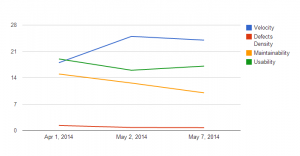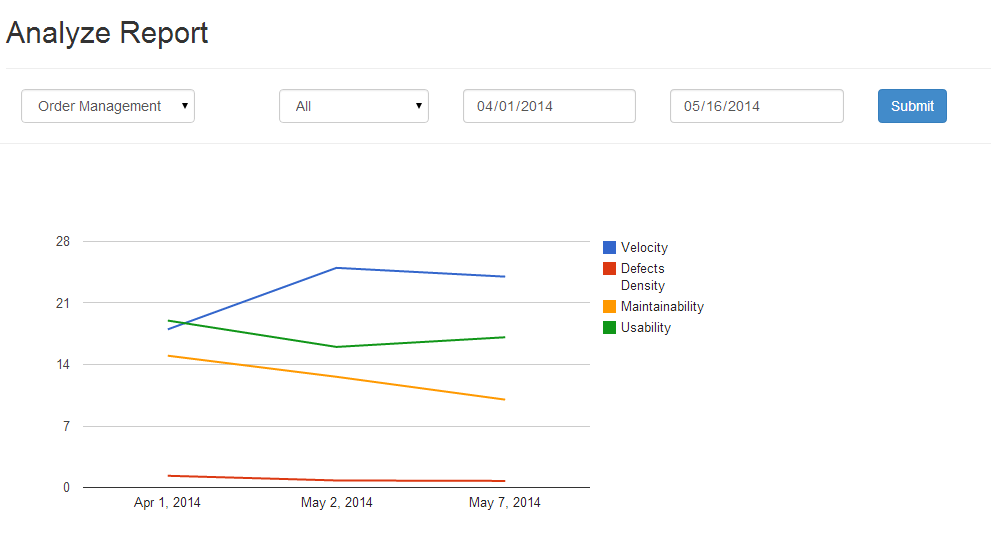
The article describes on some of the aspects related with Google Visualization APIs and how to quickly get started with it. To be able to do justice with this blog and more related blogs to come in near future, I went ahead and create a project, AgileSQM, on Google App Engine (cloud) and used following technologies to create a sample chart as shown below:
- Google App Engine as platform with Jetty as underlying web server
- Google NoSQL Datastore
- Google Visualization APIs
- Spring MVC (Component model)
- Bootstrap (UI framework)
- Eclipse IDE (with Google App Engine platform)
Helpful Bookmarks on Visualization APIs
While getting started with Google Visualization APIs and working on AgileSQM project, following are some of the pages which helped me in a great manner:
Google Charts
https://developers.google.com/chart/
Starting point for developers to get some key learning around google visualization APIs to create charts
Google Visualization API Reference
https://developers.google.com/chart/interactive/docs/reference
The page presents key Javascript objects that helps in creating the plots. Some of these objects are following:
- DataTable
- DataView
- ChartWrapper
- ChartEditor
- Query
- Events
- Data manipulation methods
Data Source Java Library – Guide & Code Samples
https://developers.google.com/chart/interactive/docs/dev/dsl_about?csw=1
A Guide describes how to use the Google Visualization Data Source Library to implement a data source. One may check out several quick references on code samples and get it going.
Code Playground for Google Visualization
https://code.google.com/apis/ajax/playground/?type=visualization
An interactive web application where one could work with code samples and get their charts done before getting down to actual coding.
Key Aspects of Developing with Visualization APIs
Following are some of the key aspects of code that one would require to be done while developing with visualization APIs:
UI-side code to create the charts
- Load Google AJAX API
- Load the Google Visualization Library and Google Chart Libraries including the corechart package
- Custom drawChart function to create the actual chart
There are some key elements to pay attention to. They are following:
// Load Google AJAX API
<script type="text/javascript" src="https://www.google.com/jsapi"></script>
<script>
// Load the Google Visualization Library and Google chart libraries including the corechart package
google.load("visualization", "1", {
packages : [ 'corechart' ]
});
google.setOnLoadCallback(drawChart);
// Custom drawChart function to create the charts
function drawChart() {
try {
var data = new google.visualization.arrayToDataTable([
['Employee Name', 'Salary'],
['Mike', {v:22500, f:'18,500'}],
['Bob', 35000],
['Alice', 44000],
['Frank', 27000],
['Floyd', 92000],
['Fritz', 18500]
],
false); // 'false' means that the first row contains labels, not data.
var chart = new google.visualization.LineChart(document
.getElementById( "divId" ));
chart.draw(data, options);
} catch (err) {
alert( err.message );
}
}
</script>
<!-- HTML div container code to contain the drawn chart -->
<div>
<div id="divId" style="width: 800px; height: 400px;"></div>
</div>
Server-side code to create Datatable/JSON object
One may need to create and send JSON object/string to client-side for creating the charts. One may use following technique:
– Use Google Visualization Data sources APIs to create DataTable and render JSON string using JSONRenderer object. Look at the code below:
DataTable data = new DataTable();
data.addColumn(new ColumnDescription("date", ValueType.TEXT, "Sprint Date"));
data.addColumn(new ColumnDescription("velocity",ValueType.NUMBER, "Velocity"));
data.addRowFromValues(dateStr, sqmdo.getVelocity());
return JsonRenderer.renderDataTable(data, true, true).toString();
– Create JSON string directly and send to client side
[adsenseyu1]
- Coefficient of Variation in Regression Modelling: Example - November 9, 2025
- Chunking Strategies for RAG with Examples - November 2, 2025
- RAG Pipeline: 6 Steps for Creating Naive RAG App - November 1, 2025

I found it very helpful. However the differences are not too understandable for me